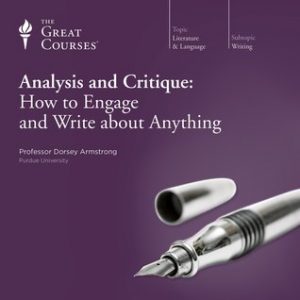
TTC – Analysis and Critique – How to Engage and Write about Anything
Original Price: $n/a
Yours FREE DOWNLOAD!!!
Author: n/a
Sale Page :_n/a
Course Lecture Titles
24 Lectures, 30 minutes / lecture
1. How to Write about Anything
What makes a particular piece of writing “good”? As you explore Professor Armstrong’s roadmap for the course, examine how a range of writing samples—including an essay by Virginia Woolf, poetry by Homer, and even a short note from a teenage girl to her mother—demonstrate essential aspects of effective writing.
2. How to Be an Effective Reader
Active, insightful reading skills are essential to any writer’s success. View the craft of writing from the reader’s perspective and train yourself to recognize nuanced moments and ideas in literary texts, including Moby-Dick and Le Morte Darthur, as well as the subtleties hidden within a practical set of driving directions.
3. How Literature Can Help
Investigate the dominant characteristics and conventions of five major genres of literature: prose, poetry, drama, essay, and autobiography. Then discover how, when used properly and with restraint, the distinct approaches of these genres can offer you a strong foundation and helpful inspiration for all sorts of writing projects.
4. Shaping Your Voice
Focus now on prose—the most common form of writing people engage with. Why is a writer’s voice such an important part of his or her work? How can you create a distinctive voice? What can authors like Hemingway, James, and Salinger teach you about the varieties of narrative styles?
5. Knowing Your Reader
A common danger for a writer is not respecting your audience. Learn how to avoid this pitfall by deducing the intended audience for Edgar Allan Poe’s “The Black Cat” and Charlotte Perkins Gilman’s “The Yellow Wallpaper,” and by closely reading student essays that miss, misjudge, or offend their intended readers.
6. The Art of the Essay—How to Start
Swift’s “A Modest Proposal” and Thoreau’s “Civil Disobedience” are two of the most famous argumentative essays in the Western literary tradition. Using their opening passages, examine why it’s so important that your opening argument be specific, be substantive, and pass what Professor Armstrong calls the “What?/So What?” test.
7. How to Organize an Argument
Continue unpacking “A Modest Proposal” and “Civil Disobedience” (along with Paine’s “Common Sense”)—this time to learn how to write an organized and effective argument. Once you’ve mastered this skill, you’ll be able to more effectively guide your readers, as well as avoid structural flaws that may distort your goals.
8. Supporting Your Argument
To write persuasively, you have to effectively explain your supporting evidence. Three skills you focus on in this lecture: explaining how a piece of evidence works in your favor; providing a direct connection between your evidence and your conclusion; and acknowledging the arguments of others to strengthen your own.
9. Finishing Strong
Enhance the way you finish essays with three key strategies. A “negative consequences” conclusion underscores the negative things that can happen if readers fail to support your argument. A “no viable alternatives” strategy suggests that alternatives to your proposal aren’t likely to work. And the “positive consequences” strategy emphasizes new possibilities.
10. The Uses of Poetry
How can poetry help you write better, even when you’re not writing poems? Here, Professor Armstrong uses poems to show that how you arrange your words can have as much of an impact as what they say. Also, delve deeper into the importance of tone and poetic devices like metaphors and similes.
11. Poetic Diction and Syntax
Continue your exploration of poetry and the ways it can enliven and strengthen writing. With the aid of poems by Gerard Manley Hopkins, Lewis Carroll, and e. e. cummings, grasp how specific words (with their literal and associated meanings) can make your writing more engaging—especially when they are used in an unconventional order.
12. Drama—Writing Out Loud
With Shakespeare’s help, discover how to tap into drama’s potential to transform you into a stronger, more confident “out loud” writer. Approaching your writing as something to be read out loud can, unlike other literary genres, clue you in to awkward turns of phrase, extremely long sentences, and other potential writing pitfalls.
13. What You Can Learn from Autobiography
Analyze excerpts from Benjamin Franklin’s autobiography for strategies to use when you are called to write about yourself. These include confining personal information to the areas of your interests, abilities, and achievements; striking a balance between self-promotion and association with others; and presenting your failures as a part of your personal development.
14. Writing and Leadership
Autobiographies are rich sources of knowledge for understanding how leadership styles and skills are developed and honed. Explore the crucial link between autobiographical writing and leadership with the aid of both Franklin and Frederick Douglass. Also, look closely at the potential benefits of using selective emotional expression in your autobiographical writing.
15. The Rules of Rhetoric
In the first of three lectures on using classical rhetoric to fashion your identity as a writer, investigate four widely used rhetorical concepts. These include commonplaces (pieces of truth wrapped in easily recognizable language), stasis (the general agreement between opposing parties about the terms of the argument), and deductive reasoning.
16. Invention and Arrangement
Turn to two broader areas of classical rhetoric: invention and arrangement. Invention refers to the process by which you generate your arguments. Arrangement refers to the way your argument is organized. Both, as you’ll learn, center on seizing opportunities to write the right thing, in the right way, at the right time.
17. Ethos and Pathos
Finish building your rhetorical tool kit by looking at ethos (the perception readers have of your reliability) and pathos (the feelings of emotion you inspire in your readers). Using literary and everyday examples, Professor Armstrong demonstrates how the best persuasive writing—whether it’s a speech or a job application—strikes a balance between the two.
18. Finding What You Need
One practical concern of writing is research. Where do you begin? How do you build an effective research schedule? What are some clues that online sources are reliable? And at what point should you stop researching and start writing? Learn the answers to these and other questions in this lecture.
19. Using What You Find
Now that you’ve learned how to find information, figure out the best ways to use it. Some of the tips and techniques you explore here include how to take effective notes, how to build your research on the work of others, and even what to do when you uncover scholarship that counters your argument.
20. Getting Started—Writing First Drafts
You’ve got your topic. You’ve done the research. Now it’s time for your first draft. Do you write for a time limit? Do you just throw out all your ideas onto the page and return later? Do you get a writing partner? Find out which of these and other methods work for you.
21. Editing—Finding What’s Wrong
Editing what you’ve written is just as important, if not more so, than actually writing it. In fact, this stage of the writing process can make the difference between a piece of writing that’s just okay and one that’s great. Here, consider two major approaches to editing: the line-by-line approach and the holistic approach.
22. Rewriting—Fixing What’s Wrong
Learn how rewriting can dramatically reshape and strengthen your work as Professor Armstrong takes you on a paragraph-by-paragraph revision of a short essay. Then, finish the lecture with vital tips to keep in mind when rewriting your work, such as clearly stating your thesis and always spelling out points.
23. Avoiding Common Errors in Grammar and Usage
Subject-pronoun disagreement. Misused apostrophes and commas. Dangling modifiers. Commonly misspelled words. Finally learn how to avoid these and other frequently made errors in grammar and usage. Any successful writing should be attentive to these errors—no matter what you’re writing or whom you’re writing to.
24. The Power of Words
In this inspirational final lecture, sample three particularly fine and engaging examples of writing—Thoreau’s Walden, Shakespeare’s sonnet number 130, and an obituary in The Economist—that bring home some of the many invaluable lessons, strategies, ideas, and advice you’ve learned and which ones you can use any time you write.
TTC – Analysis and Critique – How to Engage and Write about Anything Contains: Video, PDF´s
Download from rapidgator.net
TTC.Analysis.and.Critique.How.to.Engage.and.Write.about.Anything.rar
Download from Nitroflare
TTC.Analysis.and.Critique.How.to.Engage.and.Write.about.Anything.rar
==> Download From Mega.: (FREE DOWNLOAD)
 ***If link dead, please leave a message,or to send message to a ebusinesstores@gmail.com We will update immediately***
***If link dead, please leave a message,or to send message to a ebusinesstores@gmail.com We will update immediately***


mega upload?
Done!
No files on mega
Fixed